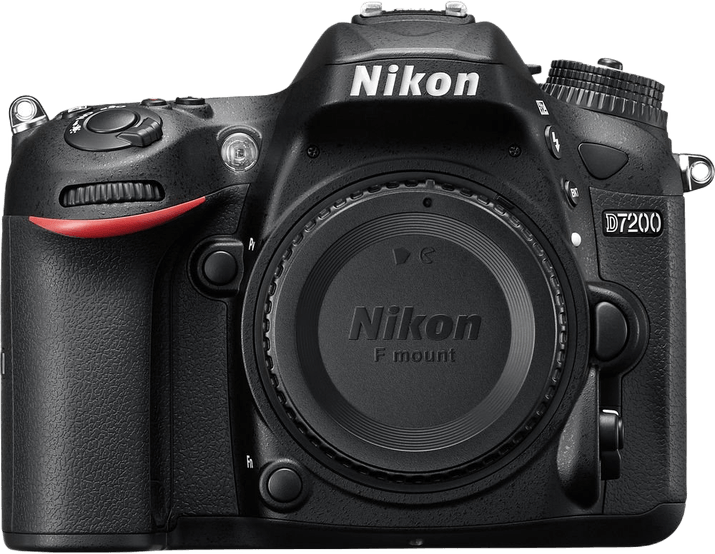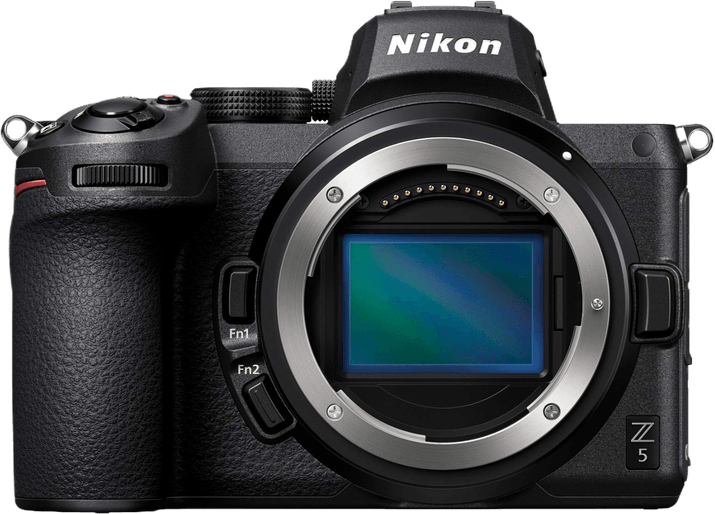Nikon D7200 vs Z5 Comparison
Nikon D7200

Nikon Z5

The Nikon Z5 outperforms the Nikon D7200 with a score of 78/100 compared to 68/100. Both cameras share similarities, such as being released by the same manufacturer and having a similar size, with the Z5 measuring 134 x 100.5 x 69.5mm and the D7200 measuring 136 x 107 x 76mm.
The Z5 has the advantage of being a mirrorless camera, which contributes to its lighter weight of 675g compared to the D7200’s 765g. This makes the Z5 more portable and convenient for on-the-go photography. Additionally, the Z5 is a more recent model, released in 2020, while the D7200 was released in 2015.
On the other hand, the D7200 has a lower launch price of $1200, compared to the Z5’s $1400, making it a more budget-friendly option. However, considering the higher score and improved features of the Z5, the extra cost may be justified for those seeking a more advanced camera.
Nikon D7200 vs Z5 Overview and Optics
The Nikon Z5 wins in optics with a score of 81/100, while the Nikon D7200 scores 71/100. Both cameras share some similar specifications: 24 megapixels, CMOS sensor type, and Nikon lens mounts. However, the Nikon Z5 stands out with its advantages.
The Nikon Z5 has a superior processor, the Expeed 6, compared to the Nikon D7200’s Expeed 4. This processor gives the Z5 better performance in terms of image processing and speed. The Z5 also has a higher DXOMARK score for the sensor, 97, while the D7200 scores 87. This means the Z5 captures higher quality images with better color accuracy and dynamic range. Furthermore, the Nikon Z5 has a full-frame sensor, providing greater detail and better low-light performance compared to the D7200’s APS-C sensor. The Z5 also features image stabilization, ensuring sharp images even in low-light conditions or with slower shutter speeds.
On the other hand, the Nikon D7200 has a slightly faster shooting speed of 6 frames per second, compared to the Z5’s 4.5 frames per second. This may be useful for photographers who need faster continuous shooting for action or sports photography.
The Nikon Z5’s superior processor, higher DXOMARK score, full-frame sensor, and image stabilization make it the better choice for those seeking top-notch image quality and performance. The Nikon D7200, despite its faster shooting speed, falls short in these aspects. Therefore, the Nikon Z5 is the clear winner in terms of optics, delivering better image quality and features for photographers.
Nikon D7200 vs Z5 Video Performance
The Nikon Z5 outperforms the Nikon D7200 in video capabilities with a score of 83/100, compared to the D7200’s 70/100. Both cameras share some common features, such as a maximum video frame rate of 60fps and built-in time-lapse functionality. However, the Nikon Z5 surpasses the D7200 in several aspects, making it the better choice for video recording.
The most significant advantage of the Nikon Z5 is its 4K video resolution, offering a maximum video dimension of 3840 x 2160. In contrast, the Nikon D7200 only provides Full HD resolution with a maximum video dimension of 1920 x 1080. This difference in resolution allows the Z5 to capture videos with greater detail and clarity, making it more suitable for professional use or those seeking higher quality footage.
The Nikon D7200 may still appeal to some users, particularly if their primary focus is photography rather than videography. Its lower video score does not necessarily render it a poor choice for video recording; it merely lacks the higher resolution and advanced features offered by the Nikon Z5. The D7200 is still capable of producing good quality Full HD videos and offers the same frame rate and time-lapse capabilities as the Z5.
Taking all factors into consideration, the Nikon Z5 is the superior choice for video recording due to its higher resolution and overall better video performance. The Nikon D7200 may serve as a satisfactory option for those less focused on videography, but for users seeking top-quality video capabilities, the Z5 is the clear winner.
Nikon D7200 vs Z5 Features and Benefits
The Nikon Z5 outperforms the Nikon D7200 in features, scoring 72/100 compared to the D7200’s 59/100. Both cameras share several specifications, such as a 3.2-inch screen size, lack of GPS, and WIFI connectivity. However, the Z5 surpasses the D7200 in several aspects, while the D7200 excels in only one area.
The Z5’s advantages include its touchscreen, flip screen, and Bluetooth connectivity. Its touchscreen enables quicker and more intuitive control, while the flip screen allows for more flexible shooting angles and improved self-portraits. The addition of Bluetooth enhances the connectivity options and facilitates seamless image transfer to devices.
On the other hand, the D7200’s only advantage over the Z5 is its higher screen resolution, which stands at 1,228,800 dots compared to the Z5’s 1,040,000 dots. This results in a slightly crisper and clearer display on the D7200, making it easier to preview images and navigate menus.
Despite the D7200’s screen resolution advantage, the Z5’s superior features make it a more versatile and user-friendly camera. Its touchscreen, flip screen, and Bluetooth connectivity provide photographers with added convenience and flexibility in various shooting situations. In contrast, the D7200’s higher screen resolution does not significantly impact the overall shooting experience, as it only marginally improves image preview and menu navigation.
Therefore, the Nikon Z5 is the better option of the two cameras, given its higher feature score and more advanced capabilities. The Nikon D7200, while offering a slightly better screen resolution, falls short in comparison due to its limited features.
Nikon D7200 vs Z5 Storage and Battery
The Nikon D7200 outperforms the Nikon Z5 in storage and battery, scoring 79/100 compared to the Z5’s 73/100. Both cameras have two memory card slots and accept SD, SDHC, and SDXC cards. However, the Z5 is UHS-II compatible, offering faster read and write speeds.
The D7200 boasts a significantly longer battery life, providing 1110 shots per charge, while the Z5 only manages 470 shots. Both cameras use EN-EL15 batteries, but the Z5 utilizes the EN-EL15c variant. The Z5 has the advantage of USB charging, allowing for more convenient power options.
Despite the Z5’s UHS-II compatibility and USB charging, the D7200’s superior battery life makes it the better choice for extended shooting sessions. On the other hand, the Z5’s features may be more attractive for photographers who prioritize faster memory card performance and convenient charging options.
Nikon D7200 vs Z5 – Our Verdict
Are you still undecided about which camera is right for you? Have a look at these popular comparisons that feature the Nikon D7200 or the Nikon Z5:
